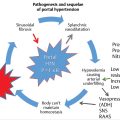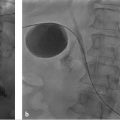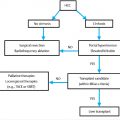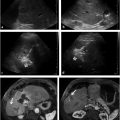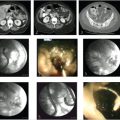25 Islet Cell Transplantation
Ashley Altman and Jonathan M. Lorenz
25.1 Introduction
Islet cell transplantation (ICT) continues to evolve as a minimally invasive alternative to whole pancreas transplantation for the treatment of select patients with type 1 diabetes mellitus. Earlier success in preventing adverse hypoglycemic events has led to continued research and improvement in the rate of sustained insulin independence, the holy grail of diabetes research. The clinical success of ICT now approaches that of gold-standard whole pancreas transplantation without the serious complications associated with major surgery. The need for immunosuppressive medication after ICT currently limits its application to a subset of diabetic patients with severe, end-stage, type 1 diabetes. However, ongoing research to optimize organ selection, organ procurement, islet cell isolation, and immunosuppressive therapy may lead to further improvements in clinical success and the broadening of the application of ICT.
25.2 Evolution of ICT and Current Practice
Approximately 11 to 22 million people worldwide are affected by type 1 diabetes mellitus. Patients with type 1 diabetes suffer from an inability to produce sufficient quantities of insulin because of a deficiency in pancreatic β-cells from either an autoimmune or idiopathic cause, resulting in chronic hyperglycemia. Hyperglycemia results in a multitude of long-term adverse consequences including microvascular and macrovascular injury, ultimately causing nephropathy, neuropathy, retinopathy, and atherosclerotic/cardiovascular disease. Hyperglycemia has traditionally been controlled by a combination of oral medications and insulin injections, both of which are accompanied by the life-threatening risk of hypoglycemic episodes. ICT is the process of allotransplantation of cadaveric donor islet cells to a recipient for the purposes of ameliorating or curing the symptoms and complications associated with diabetes and achieving long-term insulin independence. By providing a physiologic hormonal response via the body′s natural feedback mechanism, ICT and pancreatic transplantation have provided a means to control hyperglycemia while reducing the risk of hypoglycemia.
In the United States, ICT is currently offered as part of research protocols, but in many countries, ICT is offered as a standard therapeutic option. The procedure, which is described in detail later in this chapter, is an intensive, multistep process involving organ procurement by an on-call transplant surgery team, enzymatic and mechanical islet cell isolation from the donor graft, quality assurance testing for contamination and cell count adequacy, simultaneous induction of immune suppression of the recipient candidate, and, ultimately, transhepatic infusion into the recipient portal vein by interventional radiologists.
The first steps toward insulin independence were made in 1966 when the first whole pancreas transplant was performed. 1 ICT became a possibility in the late 1960s when a collagenase-based isolation protocol was developed. The development of the islet cell transfer protocol has undergone continued evolution since the first animal studies were performed in 1972, 2 but advancements beginning in 1989 led to significant milestones in ICT research such as marked reductions in hypoglycemic episodes, consequential improvements in quality of life, and increasingly sustained periods of reduced or no insulin requirements. 3 , 4 However, the studies performed during the 1980s and 1990s showed only a transient reduction of insulin requirement, with most patients returning to complete insulin dependence within 3 to 5 years, requiring additional ICTs to overcome this obstacle. 5 , 6 , 7 In 2000, Shapiro et al showed greater than 1-year, complete insulin independence in seven patients after ICT using a glucocorticoid-free immunosuppression regimen. 8 Since 2000, the protocol for ICT has been modified numerous times, with improved results largely owing to optimized steroid-free immunosuppression regimens and patient/donor selection.
Currently, widespread adoption of ICT and whole pancreas transplant is limited by the availability of donor organs. Ongoing research continues to explore the possibility of harvesting β-cell transplants from human pluripotent stem cells, which would largely circumvent this obstacle. 9 Progress continues to be made in the realm of immunosuppressant regimens and the use of new transplant sites other than portal access.
25.3 Indications
25.3.1 Medical Therapy
ICT is most appropriate for patients in whom insulin therapy has failed to adequately control blood glucose. These patients have a high risk of clinical complications and poor quality of life. Despite its limitations in this delicate population, insulin therapy is still a standard treatment approach. Typical therapy involves subcutaneous insulin injections administered at least three times daily or the use of a continuous infusion pump. Despite optimization of the insulin regimen using standard protocols, patients still face a high risk of nephropathy, neuropathy, retinopathy, peripheral vascular disease, and cardiovascular disease. Regimens of intensive insulin therapy decrease the risk of these complications but increase the risk of hypoglycemic events, as exogenous administration cannot approximate physiologic feedback mechanisms. Moreover, intensive insulin therapy is only appropriate for highly motivated patients who are compliant with frequent blood glucose monitoring and nutritional counseling. Because ICT candidates suffer from the principal complaint of hypoglycemic unawareness, intensive insulin therapy is quite limited as an alternative treatment approach.
25.3.2 Whole Pancreas Transplantation versus ICT
Pancreas transplantation is the main surgical alternative to ICT and is the gold standard for appropriate candidates. Whole pancreas transplants may be performed in isolation or concomitantly with renal transplant for patients in renal failure; uremic patients are currently treated with whole pancreas or combined pancreas and kidney transplants. The goals of these transplants are to normalize blood glucose levels while minimizing adverse events related to hypoglycemic episodes and to eventually eliminate exogenous insulin dependence.
ICT offers a number of distinct advantages over whole pancreas transplant. The main advantage of ICT is the ability to intervene earlier in the course of the disease by using a minimally invasive technique with a substantially reduced risk of morbidity; in contrast, the reported complication rate for whole pancreas transplant is as high as 36%. 10 A larger percentage of the donor population qualifies for ICT, resulting in shorter wait times. Additionally, because ICT is a minimally invasive procedure, patients have shorter hospital stays, typically ranging from 24 to 48 hours for observation and reoptimization of management of blood glucose levels. Pain is minimal and easily controlled, and recovery typically occurs within a few days. Poor surgical candidates such as those with peripheral vascular disease may undergo ICT in most cases.
Whole pancreas transplantation requires cadaveric harvest followed by open creation of vascular and bowel anastomoses typically to the iliac vessels and jejunum; permanent immunosuppression is then required. As a result, the surgery is associated with significant morbidity. The most common complication leading almost invariably to early postoperative graft loss is vascular thrombosis, which occurs in 3 to 10% of patients. 11 Other common complications include duodenal leak, peripancreatic fluid collections, graft pancreatitis, graft site and wound infections, hemorrhage, and sepsis. Reoperations to resect, reanastomose, or retransplant are not uncommon, occurring in 24 to 36% of patients because of technical failures. 10 Mortality rates are 3% at 1 year and 8% at 3 years after simultaneous pancreas and kidney transplants, and these rates are similar for patients undergoing pancreas transplant alone or pancreas-after-kidney transplant. 12 One- and three-year graft failure rates range from 11 to 20% and 20 to 40%, respectively. 13
In contrast, major complications with ICT are relatively uncommon. The most common complication after ICT is intraperitoneal and subcapsular hemorrhage, with an incidence rate reaching up to 13%. 14 The risk of bleeding is associated with the total number of ICTs performed and with the dose of heparin used. 14 Another main complication is nonocclusive portal vein thrombosis, which occurs in less than 5% of patients. 15 Other complications include transient liver enzyme elevation, abdominal pain, severe hypoglycemia, and graft loss. Bleeding after ICT is almost always minor and can be managed conservatively. However, bleeding complications in the early postoperative period after ICT threaten graft viability, as the postprocedural anticoagulation necessary for graft survival is usually terminated.
Stay updated, free articles. Join our Telegram channel

Full access? Get Clinical Tree



